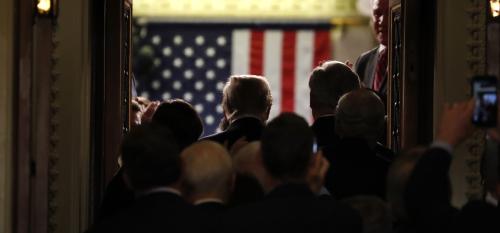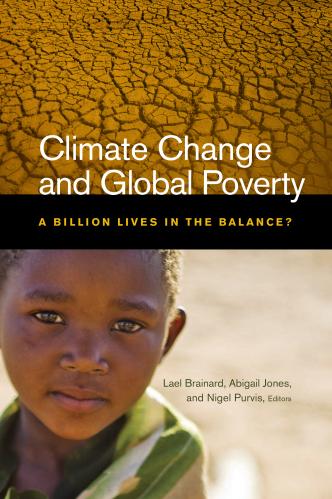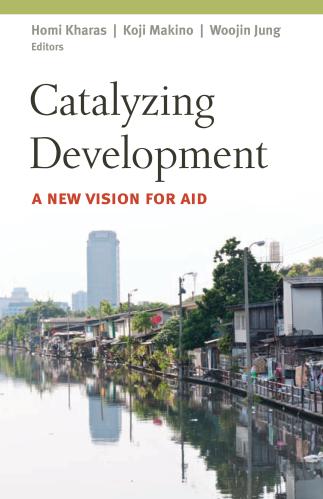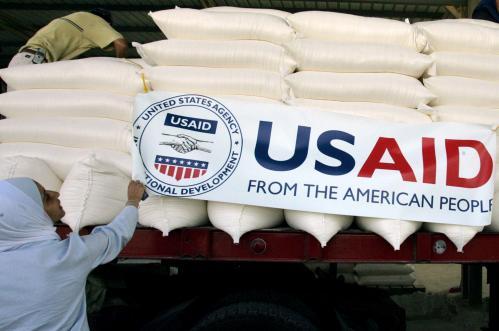From August 2-4, the Global Economy and Development Program at Brookings will host the 14th Annual Brookings Blum Roundtable, “U.S. Foreign Assistance Under Challenge.” The following is one of six briefs on topics to be highlighted at the roundtable.
Is President Donald Trump’s “America First” policy a reflection of a larger isolationist trend in public attitudes? And what do Americans think about foreign aid in particular? The answer is complex. On the one hand, recent polls suggest a robust majority support an engaged U.S. role in the world, a moral dimension to U.S. foreign policy, and giving foreign aid, especially humanitarian aid. On the other, many are dissatisfied with America’s role in the post-Cold War era, and Trump has effectively played on that disillusionment. The U.S. is seen as having overextended itself in playing a hegemonic role in the world, a role that has served corporate interests and the wealthy, but that has not effectively served the middle class, which is largely footing the bill for it. This overextension is seen as being reflected in the U.S. budget deficit, which troubles the public more than the elites.
These perceptions exert downward pressures on foreign aid spending. However, this downward pressure is not on humanitarian forms of aid but rather foreign aid spending that is seen as linked to U.S. hegemonic aspirations. Thus the Trump administration’s effort to ramp down humanitarian forms of aid while preserving aid that serves U.S. strategic interests is an inversion of the public’s priorities.
Support for an engaged and moral U.S. foreign policy
While many view Trump’s success as a sign that isolationist thinking is resurgent, polling data do not support this assumption. In response to a question regularly asked by the Chicago Council on Global Affairs, 64 percent of Americans polled in 2016 said the U.S. should take an active part in, rather than stay out of, international affairs. This is well within the normal range of those polled over the past several decades.
Among Trump supporters participating in the Chicago Council poll, the majority who favor active U.S. engagement overseas (55 percent) is somewhat lower than for the nation as a whole. Also, while in the past Republicans and Democrats had similar answers when asked about international engagement, more recently Republicans polled more negatively, while Democrats have been on an upward trend, so that the gap between them is now substantial.
Seemingly in line with this Republican view, Trump has criticized the level of U.S. engagement in the world, for example, by calling for pulling back from trade agreements. Yet a close analysis of multiple poll questions points to no significant decline in public support for trade per se, even among Republicans. Rather, there is frustration with a perception that trade expansion has benefited corporations and the wealthy, while hurting the middle and especially the working class—a view particularly pronounced among Trump supporters.
More broadly, large majorities favor an engaged foreign policy that goes well beyond an America First mentality and consensus is strong around the notion that U.S. foreign policy that pursues global values also serves America’s interests. Eight in 10 agreed1 that:
Because the world is so interconnected today, the U.S. should participate in efforts to maintain peace, protect human rights, and promote economic development. Such efforts serve U.S. interests because they help to create a more stable world that is less apt to have wars and is better for the growth of trade and other U.S. goals.
However, while a robust majority (69 percent) of Republicans agreed with this view, this number is down 10 points from the year 2000 and Trump supporters are even lower at 64 percent.
Trump’s rejection of “globalism” is also not popular. Asked which is the more important principle for U.S. foreign policy, only 21 percent of everyone polled (37 percent of Republicans) chose the statement that “the U.S. should use its power to make the world be the way that best serves U.S. interests and values.” Rather, 78 percent overall (63 percent of Republicans) chose the statement that “the U.S. should coordinate its power together with other countries according to shared ideas of what is best for the world as a whole.”
At the same time, majorities do concur with Trump’s critique of U.S. foreign policy as overextended. Fifty-five percent (61 percent of Republicans) said that, in efforts to solve world problems, the U.S. does more than its fair share. Sixty-four percent (61 percent of Republicans) said the U.S. plays the role of world policeman more than it should. Eight in 10 said other countries rely too much on U.S. protection and want other countries to shoulder more of the burden.
But this sentiment that America does more than its share in upholding international order does not carry over into support for an America First, self-interested approach to foreign aid. Americans overwhelmingly reject the idea that U.S. aid policy should be governed by self-interest rather than altruism. Asked, “If you had to choose which countries should get U.S. aid, which of these would you select as the most important?” just 9 percent chose “countries needed as trade partners,” 29 percent chose “countries important to U.S. security,” while 61 percent chose “countries with the poorest economies.”
Asked to choose between two statements, only 27 percent selected the statement that “we should only send aid to parts of the world where the U.S. has security interests,” while 71 percent chose the statement that “when hunger is a major problem in some part of the world, we should send aid whether or not the U.S. has a security interest in that region”—up from 63 percent when asked in the year 2000.
Humanitarian aid
All of these dynamics play out in relation to foreign aid. Consistent with public support for an engaged and moral foreign policy, Americans express strong support for humanitarian aid. An overwhelming 81 percent say they favor “food and medical assistance to people in needy countries” (Republicans 73 percent, Democrats 90 percent).
Arguments in favor of aid based on humanitarian considerations do well. Seven in 10 agree with the argument that “the United States should be willing to share at least a small portion of its wealth with those in the world who are in great need.”
Presented a series of possible reasons for giving aid on a 0–10 scale, one of the highest scores went to the purposeful aim “to alleviate hunger and disease in poor countries,” with a mean score of 7.6.
Asked to rate different types of foreign aid, using the same scale, the highest scoring type of aid was “child survival programs, which includes prenatal care, immunizations and nutrition,” which elicited a mean score of 7.4.
As we will see below, the context in which Americans feel the strongest pressure to reduce aid spending is when they contend with the budget deficit. However, even in this context, majorities do not favor cutting spending on humanitarian assistance.
In a May 2017 University of Maryland Program for Public Consultation (PPC) survey, respondents were presented the discretionary budget broken into 31 line items and given the opportunity to adjust each line item as they saw fit, as well as to increase or decrease revenues from a variety of sources. They were also shown how the amount of the budget deficit would change as they made changes—up or down—to the line items. Respondents were not told that they should lower the deficit—in fact, they were told there is a debate about whether doing so is important—nonetheless, most respondents did reduce the deficit, with a majority reducing it by at least $212 billion. Still, the $5 billion line item of humanitarian assistance (which was described as, “Food aid to malnourished people, assistance in the event of disasters, aid to refugees from political conflict”) was only reduced by 32 percent of respondents (47 percent Republicans), while the same number increased it. Thus, on balance, there was no change.
Similarly, a Kaiser Foundation poll asked, “If you were making up the budget for the federal government this year,” how they would treat “economic assistance to needy people around the world?” Just 3 in 10 reduced such spending.
Development assistance
The Trump administration’s call for slashing development assistance is by no means a reflection of U.S. public sentiments. While not as high as the 8 in 10 who say they favor humanitarian assistance, two-thirds say they favor “aid that helps needy countries develop their economies.” Out of a list of reasons for giving aid, “to help poor countries develop their economies” received an average 6.3 rating on a 0-10 scale, with 62 percent of respondents giving a score above 5.
Americans respond favorably to the idea that development assistance is an important strategy for fulfilling humanitarian goals. Respondents were told, “When it comes to addressing the problem of hunger, there is a debate about whether the U.S. should just provide food or if it also should help poor countries develop their economies,” and asked to choose between two statements. Two- thirds endorsed the argument that “it is important to help poor countries develop their economies so that they can become more self-sufficient,” while one-third selected the argument that “helping poor countries develop their economies is too complicated and we cannot really tell if it is doing much good.”
Similarly, when respondents were told, “Currently, there is a debate about how best to approach helping countries that are at risk for humanitarian disasters,” 63 percent agreed with the resilience theme that “rather than simply responding to disasters, the U.S. should work to help strengthen the economies of poor countries so that they will be in a better position to cope when disaster strikes.” Thirty-five percent agreed with the statement that “trying to help poor countries develop their economies is a bottomless pit and often ends up just enriching corrupt government officials.” However, among Republicans the latter statement got a bit more support (52 percent), than the former (46 percent).
Another argument for development assistance that persuaded two-thirds of those polled is that “the world economy is so interconnected today, that in the long run, helping Third World countries to develop is in the economic interest of the U.S. Many of these countries will become trading partners that buy our exports, so eventually our aid will pay off economically.” However, here too, Republicans are less sure, with only half agreeing.
Asked to evaluate specific development programs on a 0-10 scale, most foreign assistance interventions receive quite positive mean ratings, including the Peace Corps (6.6), education and training in poor countries (7.1), and programs that focus on helping women and girls in poor countries (7.0). However, other programs got a more lukewarm response, including “making very small loans to people in poor villages so they can start small businesses there” (5.6 overall, Republicans 4.7) and “promoting democracy by helping organize and monitor elections” (4.9, Republicans 4.2).
However, in the context of a tradeoff with the budget deficit, a majority of respondents favor slight trims to development assistance. In the PPC survey in which respondents were constantly confronted with the impact of their budgetary choice on the deficit, 62 percent made a reduction of at least 9 percent (from $11 billion to $10 billion) on development assistance (described as “aid to people in poverty to help them develop economically: providing loans, training technology, the Peace Corps”).
Global health
Support for aid spending on global health is similar to development assistance. In principle, Americans are supportive. In a Kaiser poll that reminded them first that “the federal government has many competing spending priorities,” asked about “efforts to improve health for people in developing countries,” only 33 percent wanted to decrease it, while 46 percent wanted to keep it the same and 19 percent wanted to increase it.
In the PPC budget study, when respondents were constantly presented with the impact of their choices on the deficit, 50.4 percent decreased it, 28 percent increased it, and 17 percent kept it the same. Thus a bare majority trimmed it 11 percent from $9 billion to $8 billion. A majority of Republicans, though, cut it by $4 billion.
Aid for strategic purposes
Contrary to the Trump administration’s push to emphasize aid that serves U.S. interests, aid for strategic purposes is the type of assistance that Americans support the least. Asked to evaluate a series of reasons for giving aid on a 0-10 scale, with 0 meaning a very bad reason and 10 a very good reason and 5 being neutral, all of the rationales based on strategic considerations fared poorly and all of them are down sharply from when this series of questions was asked in 2000.
- “To increase U.S. influence over other countries”: The mean response was 4.1 and only 25 percent gave a response above 5. Republicans were only slightly more supportive (mean 4.2, 27 percent above 5).
- “To get countries to give the U.S. access to regions where we have strategic interests”: The mean response was 4.7 and 36 percent gave a response above 5. Among Republicans, the mean response was 4.9, with 40 percent giving a response above 5.
- “Military aid, which provide weapons and material to countries that are friendly to the U.S.”: The mean response was 3.9, with 27 percent giving a response above 5.
When polled on “aid to Israel and Egypt, which includes military and economic aid,” the mean response was 4.7 with 35 percent giving response above 5. Among Republicans, though, the mean response was 5.4 (compared to 4.2 among Democrats), with 47 percent giving a response above 5 (Democrats 27 percent).
In the context of the PPC budget survey,
- “Military aid: For countries of strategic interest to the U.S, primarily military equipment and weapons, approximately one-third to Israel”: 57 percent of respondents reduced it at least 17 percent from $6 billion to $5 billion, (Republicans 56 percent, Democrats 56 percent).
- “Economic Support Fund: Economic development aid to countries of strategic concern to the U.S. such as Afghanistan, Pakistan, and Egypt”: Respondents also cut at least 17 percent from $6 billion to $5 billion by 67 percent overall. Republicans went further, with a majority cutting it by $2 billion.
Related to such support, an overwhelming 80 percent agreed with the argument that “too much U.S. foreign aid goes to governments that are not very democratic and have poor human rights records. This is not consistent with American principles.”
Views of foreign aid per se
Given this array of doubts, one might expect this would diminish support overall. Indeed, when asked to rate foreign aid per se, the net response is lukewarm—a mean response of 5.2 on a 0–10 scale (Republicans 4.5, Democrats 5.9).2
But contrary to the assumption that the public has become more negative about international engagement, when asked the same question about foreign aid in 2000 the mean response was 4.9—a bit lower than the current 5.2.
Asked whether the U.S. is spending too much or too little or about the right amount on foreign aid, recent polls have found from 49-59 percent saying that the U.S. spends too much on foreign aid. This is down from earlier decades when more than 7 in 10 said that the U.S. was spending too much.
And this does not mean that all of these people want to cut aid spending. In the PPC poll, 59 percent said that the U.S. spends too much on foreign aid, but only 45 percent wanted to reduce it. Further, only 5 percent wanted to eliminate it (Republicans 7 percent, Democrats 3 percent), down from 11 percent in 2000.
The view that the U.S. spends too much is driven in part by dissatisfaction with what aid is spent on. Asked about how much the U.S. spends efforts to reduce hunger in poor countries, only 30 percent thought that America overspends (Republicans 45 percent, Democrats 15 percent)—half as much as thought this about foreign aid per se.
The view that the U.S. spends too much also continues to be buoyed by extreme over-estimations of how much America spends on foreign aid, though this might be moderating. In December 2015, Kaiser reported a median estimate that the U.S. spends over 20 percent of the budget on foreign aid. Surprisingly, the December 2016 PPC poll found a lower number—a median estimate of just 10 percent, though the mean was 19 percent. This difference, however, may be because the PPC poll was conducted online, giving respondents the opportunity to looked it up.
Polls continue to find evidence that overestimations of the amount of aid (even if declining a bit) persist. Asked to “imagine that you found out that the U.S. spends 1 percent of the federal budget on foreign aid,” the number saying the U.S. spends too much drops 26 percent. A March 2016 Kaiser poll elicited a similar result.
More significantly, when asked how much the U.S. should spend on foreign aid, respondents’ answers continue to be far above the actual amount. In the PPC survey the mean response was 8.4 and the median 5.0. This is actually down from the more typical 10 percent in earlier polls, but is probably driven by the lower estimates of the actual amount in the PPC poll.
Conclusion
The key takeaway from all these numbers is that Donald Trump’s election should not be interpreted as indicating a swing in public attitudes toward the kinds of reductions in U.S. foreign aid programs that the Trump administration has called for. Trump did effectively speak to the public’s feeling that the U.S. does more than its fair share in global affairs and that the U.S. over reaches in its effort to play the role of global hegemon. However, the foreign aid programs Trump calls for maintaining are the ones that are least popular because they are seen as serving these hegemonic aspirations. Yet, the ones Trump has called for cutting are the ones that the public favors most, as they are consistent with the public’s support for the U.S. making a measured contribution to alleviate suffering and promote economic development around the world.
The Brookings Institution is a nonprofit organization devoted to independent research and policy solutions. Its mission is to conduct high-quality, independent research and, based on that research, to provide innovative, practical recommendations for policymakers and the public. The conclusions and recommendations of any Brookings publication are solely those of its author(s), and do not reflect the views of the Institution, its management, or its other scholars.
Brookings gratefully acknowledges Richard C. Blum and the Rockefeller Foundation for their generous support of the 2017 Brookings Blum Roundtable.
Brookings recognizes that the value it provides is in its absolute commitment to quality, independence, and impact. Activities supported by its donors reflect this commitment.
-
Footnotes
- If no other sources are indicated for polling data, this means that it is derived from a series of polls conducted in December 2016 by the Program for Public Consultation at the University of Maryland.
- Interestingly, asked to estimate the views of the average American the mean estimate was lower—4.6.









